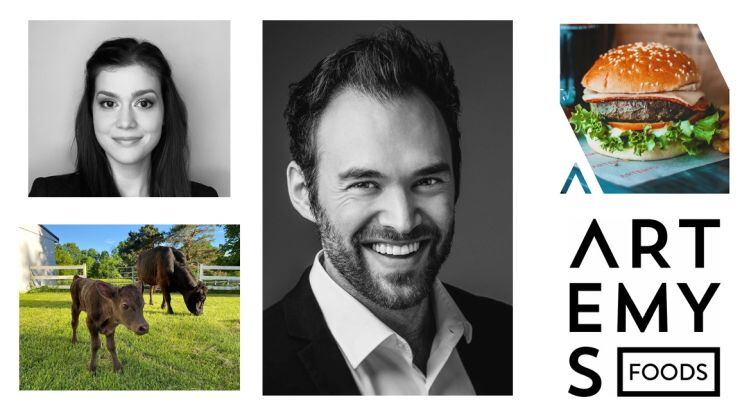The company – co-founded by Jessica Krieger and tech entrepreneur Joshua March in spring 2019 – is focused on beef, and ultimately plans to launch The Artemys Burger, combining plant-based and cell-cultured meat, as a consumer brand, said Krieger, who has a PhD in cellular and molecular biology from Kent State, Ohio.
"We’re excited to unveil the first Artemys Burger prototype in the fall. Our plan is to focus on developing cell lines and our bioprocess for scale up of bovine skeletal muscle and fat cells. It would be ideal to have a small scale commercial launch in food service; however COVID-19 has radically changed the restaurant and foodservice industry and we will adapt accordingly for our product launch."
Krieger, who was speaking to FoodNavigator-USA after joining industry association, the Alliance for Meat, Poultry and Seafood Innovation, added: “We’ve been a bit low key as we’re still getting off the ground, but I personally became interested [in cell-cultured meat] more than a decade ago after reading the UN report Livestock’s Long Shadow [which highlighted the environmental impact of animal agriculture].
“Demand for meat will double by 2050 [according to the FAO], so I really saw this as a threat to human civilization. I am also a big animal lover, so I had this crazy idea that I could reverse engineer meat.”
‘At first it seemed like science fiction…’
Fast forward to 2020 and cell-cultured meat may not be on the market yet, but with several players in the space now building pilot plants, it is on course to move from the laboratory to commercial production in fairly short order, said Krieger, who spent years working in the biomedical sciences department at Kent State and also served as a research fellow and project manager at cellular ag specialist New Harvest before moving to Oakland this summer.
“There’s been a change. At first it seemed like science fiction, but now....”
Hybrid products
So why launch with hybrid products?
In part, to lower the cost of entry, said Krieger, who plans to grow bovine fat and skeletal cells in separate bioreactors and combine them later on with plant proteins to create burgers.
But it’s also for textural reasons, she said: “Without the plant proteins we couldn’t deliver the kind of texture that people expect in a burger. The texture in animal meat really comes from the connective tissue, so if you just combine fat and skeletal muscle cells you just get kind of a mush, so you need something that will texturize the product.”
She added: “I don’t have insight into other companies’ processes, but imagine they are probably using enzymatic agents to produce some texture or food manufacturing equipment that can produce some texture. If you just combine skeletal muscle cells and fat cells you need to do some additional processing to make it like meat.”
“I think investors understand that if we really want to build a sustainable food system we really need to diversify the ways we produce animal products.”
The process: ‘Millennials and Gen Z are very comfortable with technology being used in the development of food’
So what cell types is Artemys Foods using?
“We aren’t using IPScs [induced pluripotent stem cells]," said Krieger, who is based in a laboratory at Gate510 in San Leandro, the same facility occupied by animal-free collagen startup Geltor.
"We are using primary cells that are differentiated enough that it’s easy to differentiate them into their final phenotype, which would be a multinucleated muscle cell, or a fat cell that has lipid droplets inside the cell, for example. We have our own partnership with a farm where we can collect tissue biopsies [without harming animals].”
Asked whether Artemys Foods is using genetic engineering, she added: “We are using genetic engineering and it’s my belief that it should be embraced as a tool to help us produce scalable, high quality and low-cost food products.
“Millennials and Gen Z are very comfortable with technology being used in the development of food and they are not as conservative as some of the older generations. They are the most likely to embrace these kinds of foods.”
Scalability: It depends on the bioreactor you’re using
As for scalability, it depends on the kind of bioreactor you use, said Krieger. “So with stir tank bioreactors you can get environmental conditions at about 500 liters that can scale to thousands of liters, but if you have different bioreactors or different environments that happen throughout your bioprocess, that can really influence and change how the cells grow.
“We’re using bioreactors with a proven track record for scale up, and we're developing bioprocesses that can grow a cell density of a few million cells per mL. The number of cells per mL is important because it determines the harvested mass."
Growth media: Multiple approaches to producing growth factors
As for progress in developing cost-effective FBS-free (fetal bovine serum-free) growth media, she said, “There is plenty of work on growing proteins and growth factors from fermentation cultures and there are also people growing mammalian growth factors in plants, and both strategies are interesting.”
Naming: ‘We like the term ‘cultivated’ meat’
When it comes to terminology – a source of some debate in the nascent industry, which has yet to coalesce around wording that could make sense for consumers and regulators without alienating the conventional meat industry – Artemys Foods prefers ‘cultivated’ although it’s open to other suggestions, said Krieger.
“We like the term ‘cultivated’ [which performed well in consumer research conducted by Mattson last year], and as we’re building a consumer brand, we have to be careful about what we call our products.
“But ‘cultivated’ is representative of the science, we’re cultivating cells, it’s not provocative and it provides a comparison to more traditional forms of cultivation for foods, such as yogurt or beer or other fermentation systems.”
‘We have done quite a bit of fundraising…’
As for funding, “We’ve relied on institutional and angel investors,” said Krieger, who has been steadily building the team in recent months.
"We’re around a dozen people now... We have done quite a bit of fundraising, we finished our seed round but can’t reveal more than that right now. But it’s been an interesting time to try and raise money because the coronavirus has revealed the pressure the meat industry is under.
“I think investors understand that if we really want to build a sustainable food system we really need to diversify the ways we produce animal products.”
At this stage, she said, investors are investing in the team, as the company is still very much in the R&D phase, “But they also looked at us with a magnifying glass and were able to see why our strategy might be more successful than some of the others out there. We really stood apart to a lot of them.
“With regards to the model, they felt we had correctly identified the right problems to solve in the model and we had a clear model to commercialization.”




